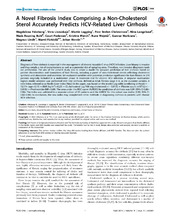A novel fibrosis index comprising a non-cholesterol sterol accurately predicts HCV-related liver cirrhosis
Ydreborg, Magdalena; Lisovskaja, Vera; Lagging, Martin; Christensen, Peer Brehm; Langeland, Nina; Buhl, Mads Rauning; Pedersen, Court; Mørch, Kristine; Wejstål, Rune; Norkrans, Gunnar; Lindh, Magnus; Färkkilä, Martti; Westin, Johan
Peer reviewed, Journal article
Published version

View/
Date
2014-04-03Metadata
Show full item recordCollections
Original version
https://doi.org/10.1371/journal.pone.0093601Abstract
Diagnosis of liver cirrhosis is essential in the management of chronic hepatitis C virus (HCV) infection. Liver biopsy is invasive and thus entails a risk of complications as well as a potential risk of sampling error. Therefore, non-invasive diagnostic tools are preferential. The aim of the present study was to create a model for accurate prediction of liver cirrhosis based on patient characteristics and biomarkers of liver fibrosis, including a panel of non-cholesterol sterols reflecting cholesterol synthesis and absorption and secretion. We evaluated variables with potential predictive significance for liver fibrosis in 278 patients originally included in a multicenter phase III treatment trial for chronic HCV infection. A stepwise multivariate logistic model selection was performed with liver cirrhosis, defined as Ishak fibrosis stage 5–6, as the outcome variable. A new index, referred to as Nordic Liver Index (NoLI) in the paper, was based on the model: Log-odds (predicting cirrhosis) =2 12.17+ (age60.11) + (BMI (kg/m2)60.23) + (D7-lathosterol (mg/100 mg cholesterol)6(20.013)) + (Platelet count (x109/L)6(2 0.018)) + (Prothrombin-INR63.69). The area under the ROC curve (AUROC) for prediction of cirrhosis was 0.91 (95% CI 0.86– 0.96). The index was validated in a separate cohort of 83 patients and the AUROC for this cohort was similar (0.90; 95% CI: 0.82–0.98). In conclusion, the new index may complement other methods in diagnosing cirrhosis in patients with chronic HCV infection.
